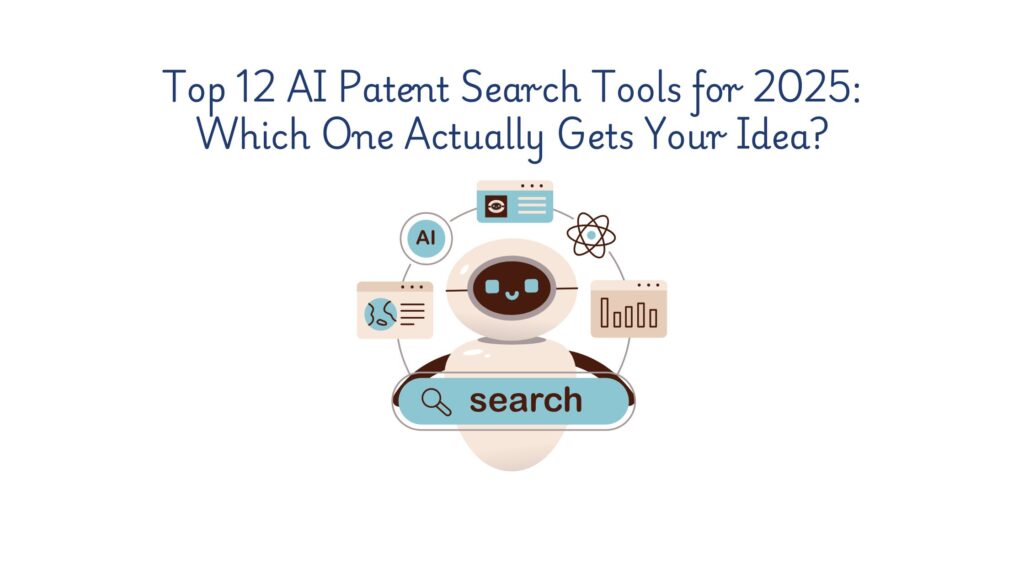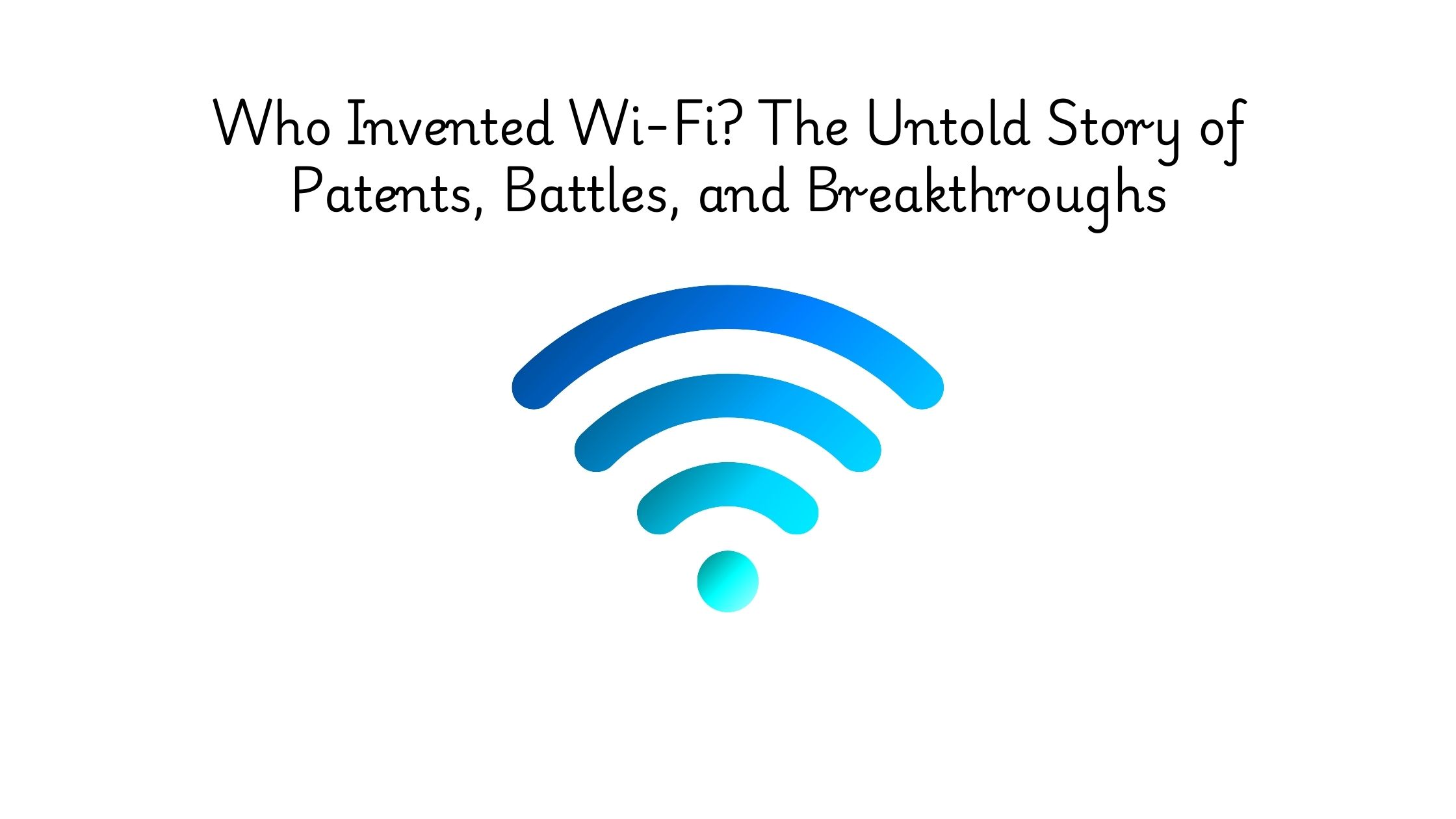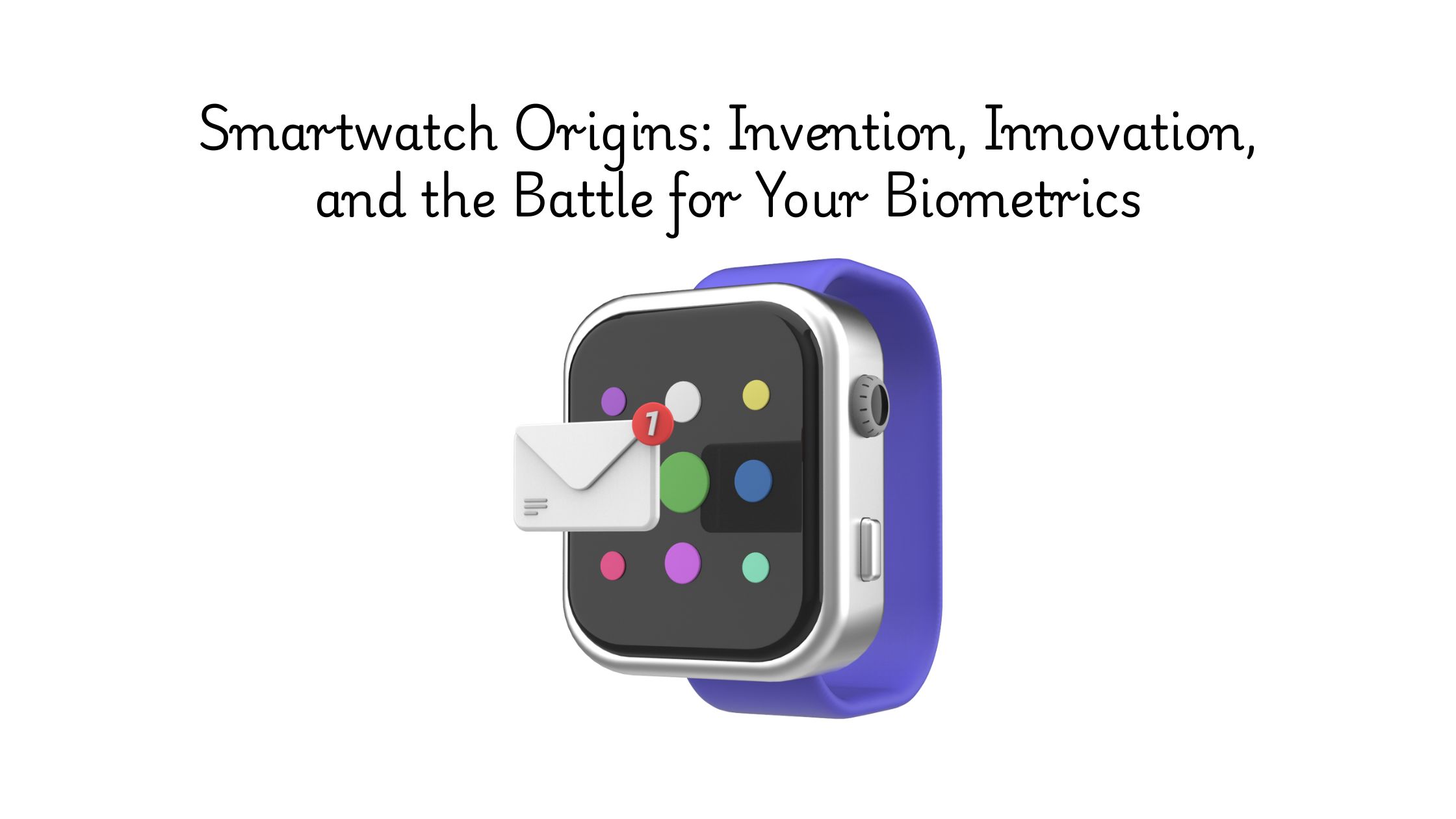AI patent search tools are changing the way innovators validate what they build. And if you’re here, you’re probably in that exact moment.
You’ve got the idea. Now comes the hard part: proving it’s new.
Before a single line of code or a prototype hits the table, you’re deep in the search, looking for existing patents, prior art, and anything that could derail your filing down the road.
That’s when you hit the wall. Traditional search tools demand you speak their language- keywords, Boolean operators, patent class codes. But your invention doesn’t live in syntax. It lives in structure, function, and intent.
That’s where AI makes a difference. These tools don’t just speed up searches. They help you describe what you’re building in plain language and return results that actually make sense. They parse meaning, map ideas to claims, and highlight what matters, not just what matches.
In this guide, we break down 12 AI patent search platforms leading the way in 2025. You’ll see how each approaches the problem differently, from semantic reasoning to citation-based search to visual pattern recognition.
Whether drafting a filing, clearing prior art, or exploring freedom to operate, this list will help you find the tool that aligns with how you think and what you’re building.
#1. Global Patent Search – AI That Understands Both Ideas and Claims
Patent searches shouldn’t require you to speak Boolean. With Global Patent Search(GPS), you don’t have to.
You can describe your idea in plain English, just as you would to a colleague, and the tool finds related patents by understanding the functional features behind your invention.
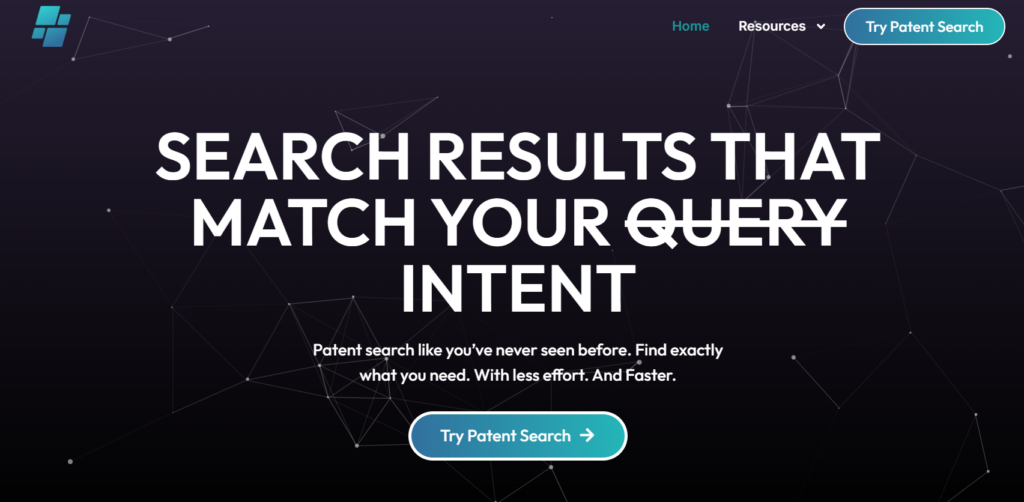
Source: GPS
Instead of matching keywords, GPS maps your input to real patent claims using semantic intelligence. This makes it ideal for early-stage ideation, novelty assessment, or whitespace exploration.
Want to see it in action? Here’s how GPS analyzed feature-level overlaps in self-healing materials, surfacing patents you’d likely miss using traditional search methods.
If you already have a specific patent in mind, Global Patent Search also supports patent number input. Drop in an existing patent, and GPS will break it down feature by feature, mapping each part to relevant claims across the global database.
Source – Global Patent Search
It’s a powerful way to validate novelty, spot potential conflicts, or explore competitive coverage.
For instance, here’s an example using patent US7233664B2 on secure device communication, where GPS revealed prior art risks through intelligent claim mapping: You can find the entire analysis here.
Whether you’re drafting a patent, validating FTO, or conducting invalidity searches, GPS cuts through irrelevant noise and surfaces what matters, even across jurisdictions and languages.
Built For: The People Who Do Real Patent Work
- Engineers and inventors who want to validate novelty before investing in filing.
- IP analysts who are responsible for finding prior art fast and missing nothing.
- Patent attorneys who need semantic claim comparisons, not keyword noise.
- R&D leaders and innovation teams looking for a smarter way to explore freedom to operate.
Whether explaining an idea or analyzing an issued patent, GPS adapts to how you think, not the other way around.
Quick Snapshot: What Global Patent Search Delivers?
| Capability | GPS Delivers |
| Natural Language Search | Describe your invention in plain English, skip the Boolean |
| Feature-to-Claim Mapping | Break down ideas or patents into parts, align with global claims |
| Patent Number Input | Analyze any granted patent for semantic overlap and prior art |
| Global Jurisdiction Coverage | Full-text search across 100+ patent offices |
| Semantic Indexing | Finds what keyword-based systems miss |
| Built for Real Workflows | Ideal for FTO, invalidation, clearance, and early-stage filing |
While Global Patent Search rethinks the experience from the ground up, the next set of tools takes a different approach. That is layering AI on top of one of the most trusted editorial patent datasets in the world. Let’s take a look.
#2. Derwent Innovation – Enterprise-Grade Patent Intelligence, Augmented by AI
Derwent Innovation is built for scale. But more importantly, it’s built for trust. Before AI was a buzzword, Derwent set the standard for structured patent information through the Derwent World Patents Index (DWPI).
Now, that foundation is paired with transformer-based language models to surface smarter results from a database that spans over 100 jurisdictions.

Source: Derwent Innovation
What separates Derwent from almost every other tool on this list is its human-in-the-loop model. Clarivate’s editorial team writes every abstract, not scraped, not machine-summarized.
That means when you search using AI, the engine is working with normalized, high-quality data that actually makes sense. The result is smarter retrieval, better disambiguation, and fewer dead ends.
If your workflow spans legal, competitive, and R&D teams, Derwent’s integrations with Darts-ip and CompuMark make it a powerful hub for everything from patent litigation tracking to brand protection. It’s not light or beginner-friendly, but it’s not trying to be either.
Derwent is for teams that already take IP seriously and want AI that amplifies a process, not replaces it.
Built For: Enterprise legal teams, IP analysts managing global portfolios, and decision-makers who rely on editorial-grade data.
#3. PatSnap – AI-Powered Insights Across the Innovation Lifecycle
PatSnap doesn’t just search patents. It helps teams build around IP.
Unlike tools that add AI as a layer, PatSnap has baked it into the entire workflow. You’ll see it in natural language search, semantic matching, prior art scoring, and even automated claim summaries.
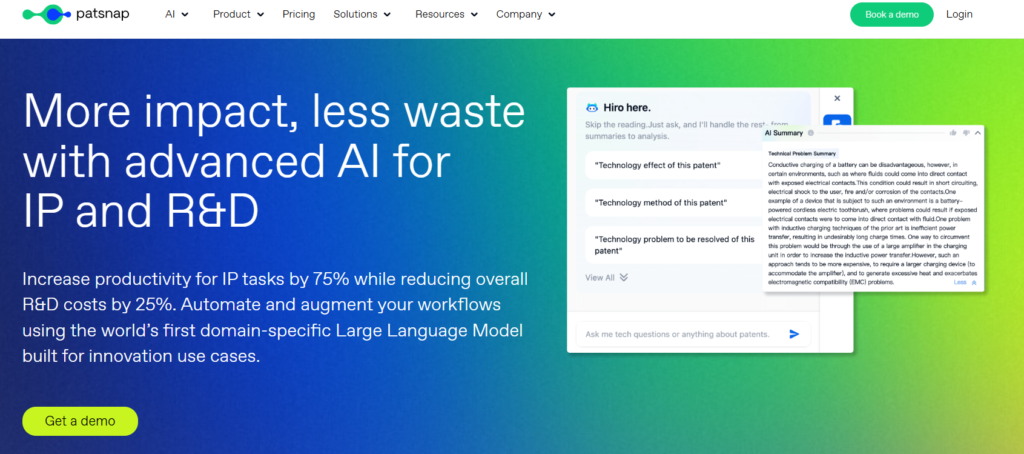
Source: Patsnap
Where it stands out is post-search. Visual tools like claim charts and whitespace maps help R&D, legal, and product teams align quickly. You don’t just get a list; you get clarity on what’s been done and where the gaps are.
The CoPilot tool is built on a custom LLM trained on patent, legal, scientific, and market data. It takes dense technical language and turns it into summaries, comparisons, and strategic insights.

Source: Patsnap
PatSnap is built for cross-functional teams who need more than just search. It connects IP with decision-making across patentability, FTO, and competitive tracking.
It’s not light. But it’s built to be the IP command center for serious innovation teams.
Built For: R&D-led companies, patent attorneys, and product teams who want patent searches to drive strategy.
#4. Ambercite – AI That Finds What Keywords Miss
Ambercite doesn’t care what words you type. And that’s the point.
Instead of chasing keywords or semantic matches, it maps how patents are connected through citations. Think of it as a search engine trained not on documents but on how examiner behavior links them.
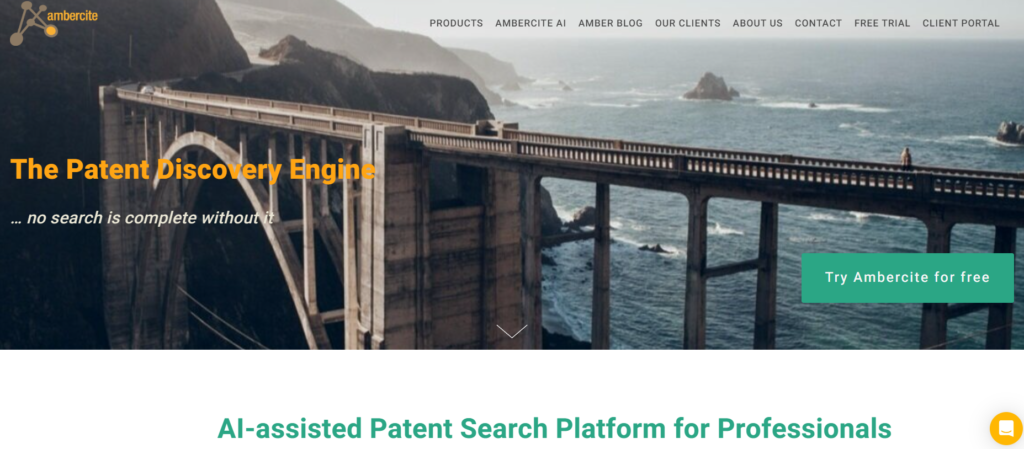
Source: Ambercite
You feed it a patent or example set. Ambercite returns a web of related filings that don’t need to share a single keyword to be relevant. It’s built on 175 million citation relationships, using proprietary algorithms to score relevance based on who cites what and why.
This makes it powerful for uncovering hidden prior art, especially when the language is different or the tech comes from adjacent fields. You don’t need to write a Boolean query or describe your invention. You just need a starting point.
Ambercite is built for strategic workflows: FTO, invalidation, and risk discovery. If you think like an examiner, or want to, it’s the second brain you didn’t know you needed.
Built For: IP strategists, legal teams, and search pros who care more about what’s connected than what’s written.
#5. PatSeer – AI-Powered Patent Research with Analyst-Level Control
PatSeer is built for teams who want power under the hood. It gives you deep search control without slowing you down.
Its AI engine supports natural language input, technical descriptions, and hybrid queries. Behind the scenes, it uses ML models trained on both patent and non-patent literature to understand your intent, not just your syntax.

Source: Patseer
Once the results are in, tools like the AI Re-Ranker and AI Recommender kick in. They prioritize what’s most relevant and flag results you might have missed. It’s like having an analyst double-check your work instantly.
What makes PatSeer stand out is its flexibility. You can define your own taxonomy. The AI Classifier learns from it and adapts to your workflow. Add tagging, annotations, and multi-user dashboards, and you’ve got a platform that mirrors how real IP teams work.
This isn’t a plug-and-play tool. It’s a research command center made for pros who want precision and structure at scale.
Built For: Search analysts, legal researchers, and power users who need search tools that adapt to their process, not the other way around.
#6. PQAI – Open-Source Patent Search, Built for the Rest of Us
Most patent search tools assume you know what you’re doing. PQAI assumes you don’t and that’s what makes it different.
It’s free, open-source, and designed for early-stage inventors, students, and anyone who doesn’t have an in-house IP team. You just describe your idea in plain language. PQAI’s semantic engine does the rest, pulling relevant patents and research papers without asking you to write a Boolean string.

Source: PQAI
There are no class codes to navigate. No premium tiers. No login walls. Just simple, AI-powered search focused on accessibility.
Built by a nonprofit consortium, with backers like AT&T, GreyB, and the Georgia Intellectual Property Alliance, PQAI aims to make IP search part of the idea stage, not an afterthought.
It ranks results by confidence and relevance, helping users spot risks early, even if they’ve never read a patent before.
Built For: Inventors, students, accelerators, and first-time founders who need answers, not syntax.
#7. The Lens – Open Patent and Scholarly Intelligence for Everyone
The Lens is an open-access platform that links 155 million global patent records with over 270 million scholarly articles, bridging the gap between labs and legal filings.
Built by Cambia, a nonprofit with a mission to democratize innovation, The Lens gives researchers and inventors a unified view of how science turns into IP, and vice versa.
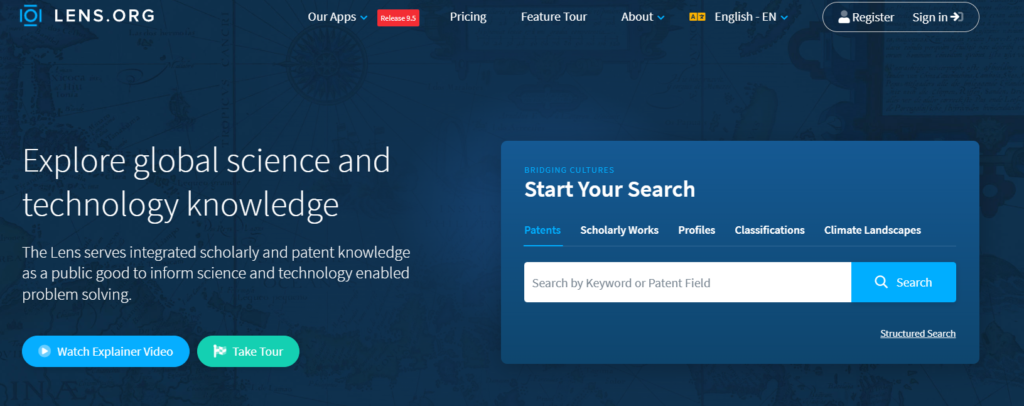
Source: The Lens
You can search using natural language or advanced Boolean. You can filter, export, or analyze at scale. But what makes it special is its dual-indexed model: patents and papers aren’t siloed. They’re connected. You see citations flowing across both worlds.
For biotech users, the PatSeq tool is a standout, surfacing over 495 million DNA, RNA, and protein sequences disclosed in patents, something rarely found outside niche databases.
The Lens doesn’t just deliver data. It reveals innovation relationships, helps track inventors and collaborators, and makes IP analysis accessible to the research world.
Built For: Researchers, university labs, biotech founders, and policy analysts tracking the full journey of innovation.
#8. IPRally – Graph AI That Understands How Patents Actually Work
IPRally replaces keyword search with Graph AI – a smarter way to map the structure and meaning behind inventions.
You can start with a patent number, free-text description, or even an image. The system translates your input into a graph structure, identifying key elements and relationships. It then searches based on technical alignment, not just language.
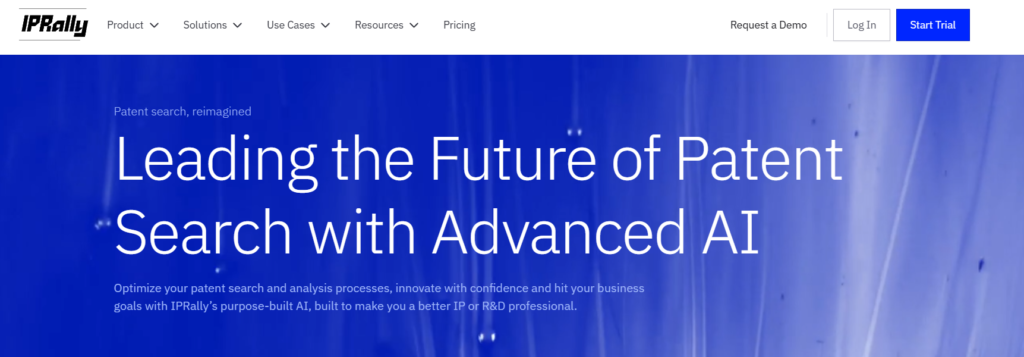
Source: IPRally
This makes IPRally powerful for discovering prior art that’s buried under different phrasing, disciplines, or formats. The Image Search feature lets you upload photos, diagrams, or product sheets and find conceptually related patents, even if they use entirely different terminology.
Trained on millions of examiner citations, IPRally’s Graph AI mirrors how real patent experts think. Each result comes with explainable logic showing why it was matched, not just what was found.
Its Ask AI feature brings generative capabilities into the mix. You can ask questions about a single patent, or an entire result set, and get fast, technical insights without scanning pages manually.
Built For: Patent professionals, engineers, and IP analysts who want deeper accuracy, visual reasoning, and explainable results.
#9. Visualize IP – AI-Powered Search for Design Patents That Thinks Visually
Design patents are visual. Traditional search tools aren’t.
Visualize IP fixes that. Built by former USPTO examiners, data scientists, and seasoned patent searchers, it uses advanced computer vision to compare over 70 million images and return highly accurate visual matches.
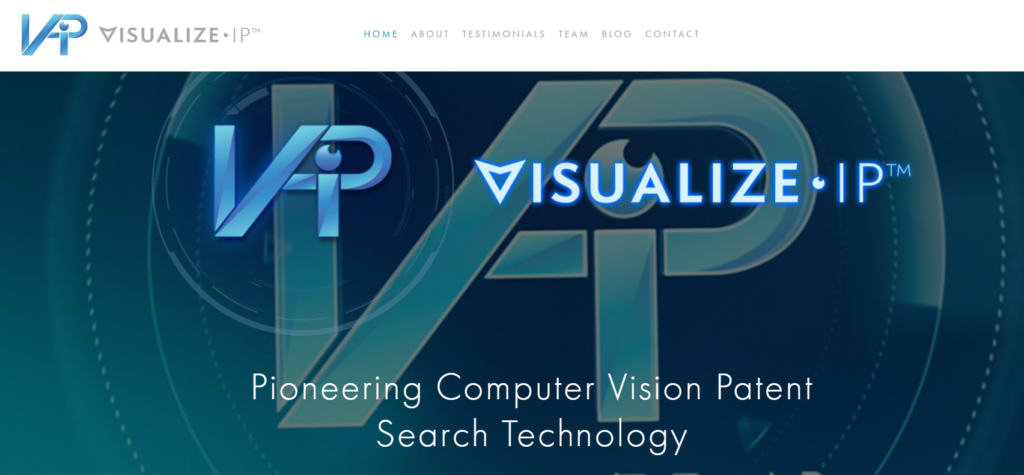
Source: VisualizeIP
This is no keyword search. The system analyzes shape, contour, proportion, and visual structure catching design similarities that text-based tools often miss. It’s especially powerful for design FTO, novelty assessments, and invalidity research.
By automating what was once a manual, error-prone process, Visualize IP cuts search time dramatically and has been shown to reduce related costs by up to 90%.
The interface is intuitive. The reports are clear. And the search results are instant, giving IP teams the insight they need without the friction of legacy tools.
Built For: Design patent professionals, product teams, and attorneys who need visual intelligence.
#10. InnovationQ Plus – Semantic Search Meets Technical Depth
InnovationQ Plus is built for people working at the edge of science and IP. Its core engine, Semantic Gist®, is designed to understand your idea.
You can describe your invention in plain English, and the system returns patents and technical papers that match the meaning, even when phrased entirely differently. No Boolean. No rigid syntax.

Source: InnovationQ+
What makes it stand out is the integration with IEEE full-text literature, including standards, journals, and conference papers. This is a huge advantage for electronics, telecom, and semiconductor teams, where critical insight often lives outside the patent database.
With one search, you get semantically ranked results across patents and scientific disclosures, revealing innovation threads that most tools can’t see.
It also comes with visualization features like HD-Analyze and semantic maps, helping you spot whitespace, track competitors, and cluster technologies without leaving the platform.
If you’re working in a complex technical field and need both precision and scientific depth, this is the tool built for your reality.
Built For: Deep tech teams, research analysts, and IP strategists working across patents and scientific domains.
#11. Dolcera – AI-Driven Patent Search and Competitive Intelligence
Dolcera is built for IP teams that treat patent search as strategy. At its core is the Dolcera Patent Classification System (PCS), an ML-powered engine that processes over 110 million patents, refreshed daily.
It supports all major search types, Boolean, semantic, near, fuzzy, and command, but wraps them in a UI that’s simple enough for non-specialists. You get precision and speed, whether you’re looking for prior art or mapping entire tech domains.
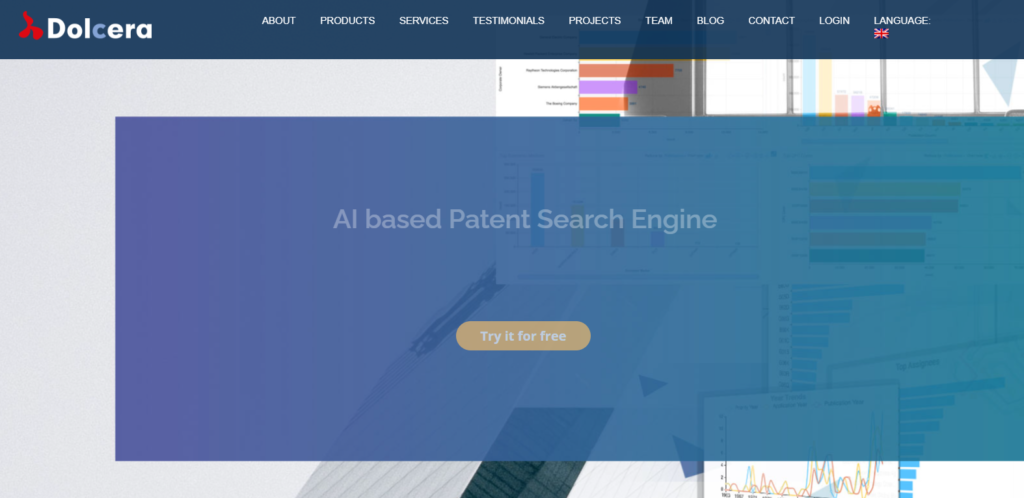
Source: Dolcera
The platform doesn’t stop at search. It connects patents to their ultimate owners, helping users visualize competitive landscapes, track innovation by company, and align IP data with business goals.
Dolcera’s second tool, Majjanti, brings AI-driven enterprise search to broader business use cases. From external innovation scouting to regulatory mapping, it turns raw IP data into actionable knowledge.
If you’re managing complex portfolios or advising on patent strategy, Dolcera gives you the structure and scale to move fast and think big.
Built For: Enterprise IP teams, legal advisors, and innovation leaders needing portfolio clarity and ownership analytics.
#12. Patent Inspiration – Innovation Trends Hidden in Patent Text
Patent Inspiration is designed for curious minds, not just patent professionals.
It offers flexible search, from simple keywords to advanced filters, across patents from 90+ countries. You can filter by applicant, inventor, class, or keyword, then visualize the results with dynamic charts and trend graphs.
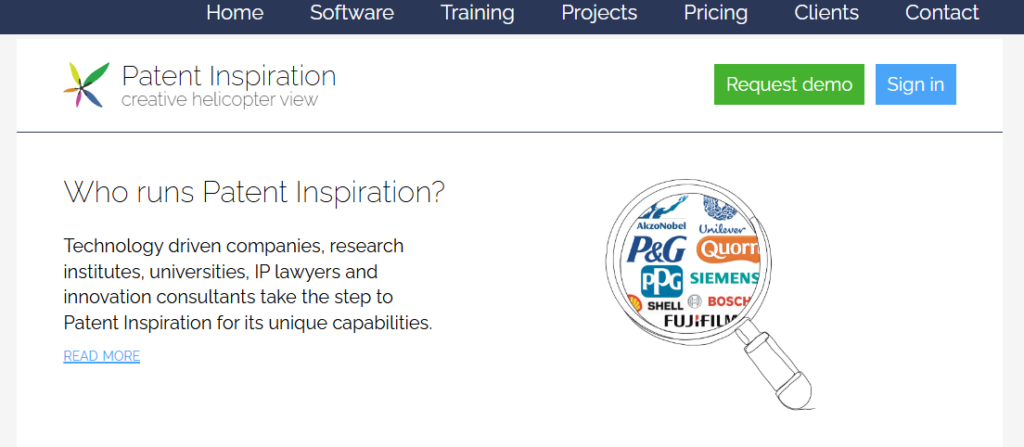
Source: Patent Inspiration
Where it shines is in pattern analysis. The system can surface frequently used phrases, concepts, or shifts in terminology, helping you spot emerging technologies or untapped opportunities early.
The platform is easy to use, with clear exports, alerts, and sharing tools that support collaborative research or ongoing monitoring.
It also uses a freemium model, giving individuals and small teams powerful tools without needing an enterprise budget.
If you’re trying to understand where innovation is headed, not just what’s already filed, Patent Inspiration is a fast, visual way to get there.
Built For: Product teams, researchers, and early-stage innovators who want to explore patent trends without a steep learning curve.
Side-by-Side Breakdown of the Top AI Patent Search Tools
Not all AI patent search tools solve the same problem. Also some are built for totally different users. Whether you’re doing an early novelty check or managing a global patent portfolio, this table breaks down the core features, strengths, and use cases of each platform to help you choose wisely.
| Tool | AI Method | Best For | Search Type | Notable Differentiator | Jurisdiction Coverage | Pricing |
| Global Patent Search | Feature-level semantic mapping | Inventors, SMEs, IP teams | Natural language, Patent number | Maps your idea to real claims, feature by feature | 100+ global offices | Paid |
| Derwent Innovation | Transformer NLP + editorial data | Enterprise legal and IP teams | Semantic, Boolean | Human-written abstracts (DWPI) + enterprise workflow stack | 76 full-text, 100+ total | Paid |
| PatSnap | Semantic + Predictive AI | R&D-led orgs, IP attorneys | Natural language, Semantic | End-to-end IP intelligence, AI-powered visuals | 116 jurisdictions, 140M+ docs | Paid |
| Ambercite | Citation network AI | FTO, invalidation, competitive research | Citation-based | Doesn’t use text — finds links through examiner behavior | 106M+ patents | Paid |
| PatSeer | ML + AI Classifier + Re-Ranker | Analysts, legal researchers | Hybrid, Semantic, Boolean | Custom taxonomy, analyst-level control | 170M+ across 108+ countries | Paid |
| PQAI | Open-source Semantic NLP | Solo inventors, students, accelerators | Natural language | Confidence-ranked, no Boolean, open access | US patents + 11.5M research | Free |
| The Lens | Semantic + Citation Mapping | Researchers, biotech, policy analysts | Natural, Boolean, Structured | Patents + scholarly data, PatSeq for bio sequence search | 100+ jurisdictions | Free |
| IPRally | Graph AI + Generative AI | Engineers, patent pros, power users | Free-text, Patent number, Image | Explainable results, visual mapping, conversational “Ask AI” | 120M+ docs, updated weekly | Paid |
| Visualize IP | Computer vision + image similarity AI | Design patent attorneys, product teams | Image-based | Searches based on appearance, not just text | 58 design patent jurisdictions | Paid |
| InnovationQ Plus | Semantic Gist® + IEEE integration | Deep tech teams, R&D, legal analysts | Natural language | Access to IEEE full-text tech literature | US, EU, CN, JP, KR, WIPO, etc. | Paid |
| Dolcera | Semantic ML + PCS Search + Analytics | IP managers, innovation leads | Semantic, Boolean, Fuzzy, Command | Patent ownership mapping + business-aligned IP insights | 110+ countries | Paid |
| Patent Inspiration | Text AI + Pattern Analytics | Product teams, researchers, innovators | Keyword, Advanced filters | Visual trend mapping + freemium access | 90+ countries incl. WO, EP, US | Freemium |
From Complexity to Clarity: Smarter Search Starts With the Right Fit

Every tool in this list solves a different slice of the patent search puzzle – from semantic retrieval to visual matching, from graph reasoning to citation networks. And for some workflows, those tools make sense.
But if you’re looking for a platform that speaks your language and understands what you’re building at a feature level, Global Patent Search goes further than any other tool on this list.
You don’t need to fight with syntax or settle for keyword matches. GPS breaks down your idea into functional elements, maps them to real patent claims, and shows you what’s novel and not with uncommon precision.
It’s fast. It’s intuitive. And it’s built for people who don’t want to gamble with their search.
If you’re serious about protecting what you’re building, this is the tool that gets your idea, not just your input. Explore the tool today at Global Patent Search.
Frequently Asked Questions
1. How does AI improve the accuracy of patent searches?
AI shifts the focus from exact keyword matching to understanding the meaning behind your idea. It identifies semantic patterns, context, and concept-level similarities and uncovering patents that traditional searches miss. This leads to fewer false positives, fewer blind spots, and faster clarity, especially in edge cases or highly technical domains.
2. Can AI tools replace manual patent search and analysis?
Not completely, but they can take care of the heavy lifting. AI handles scale, speed, and surface-level filtering far better than humans. That said, final decisions still benefit from expert review. The best setups use AI for discovery and pattern recognition, and humans for validation and strategic judgment.
3. What’s the difference between semantic and Boolean patent search?
Boolean search relies on exact keywords and operators (AND, OR, NOT). Semantic search, powered by AI, interprets context and meaning, not just text. It surfaces relevant results even when phrased differently. Boolean gives you precision if you know what to look for. Semantic works better when you’re still exploring.
4. How does Global Patent Search compare to tools like PatSnap or Derwent?
PatSnap is broad and lifecycle-driven. Derwent offers editorial-grade data for legal teams. Global Patent Search focuses on what matters most early — understanding your idea. It maps your invention to real claims, feature by feature. For clarity, speed, and intuitive input, GPS often gives a cleaner, faster start.
5. Are there free AI-based patent search tools available?
Yes. PQAI and Lens are two notable examples. PQAI is open-source and designed for inventors and students. The Lens offers broad access to patents and academic research.
6. Can I use AI tools to check if my idea is already patented?
Absolutely. That’s one of their best use cases. Just describe your idea in plain English, and the AI can surface existing patents with similar claims or concepts. Tools like Global Patent Search even show which features overlap, helping you assess novelty and reduce the risk of rejection.
7. Is AI reliable for freedom-to-operate (FTO) searches?
AI helps accelerate and expand FTO analysis by surfacing relevant prior art faster. But because FTO involves legal interpretation and risk thresholds, you should pair AI results with expert legal review. Still, it gives you a stronger starting point and cuts weeks out of the research phase.

